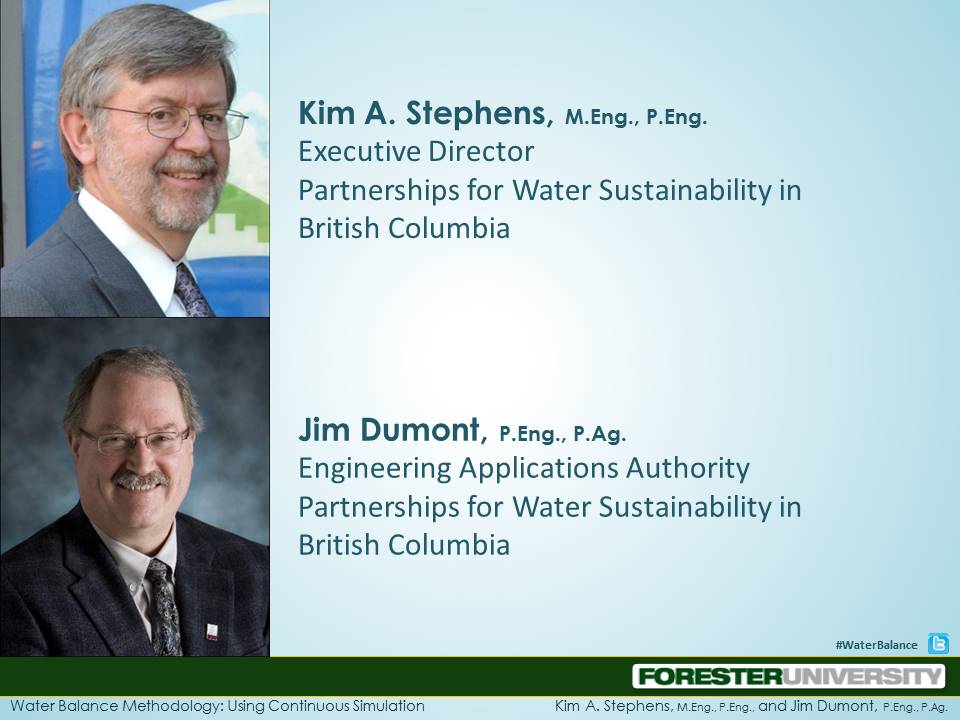WHAT HAPPENS ON THE LAND DOES MATTER! – hosted by Forester University (May 2017), the Water Balance Webinar from British Columbia introduced a North American audience to the methodology that underpins vision for “Sustainable Watershed Systems, through Asset Management”
Note to Reader:
Located in California, Forester University offers live, educational webinars and on-demand webcasts for professionals in Stormwater, Water Efficiency, Erosion Control, and the public utility sector to earn credits, or to simply learn something new.
The Partnership for Water Sustainability in British Columbia is partnering with Forester University to share, via webinars and a future library of webcasts, the British Columbia innovation and experience that has resulted in the whole-system, water balance approach that is the hydrologic modelling foundation for Sustainable Watershed Systems, through Asset Management.
The webinar was a co-presentation by the Partnership’s Kim Stephens (Executive Director) and Jim Dumont (Engineering Applications Authority). Kim Stephens provided context in an opening segment. Click on the link below to view his presentation as posted on YouTube.
To view the entire webcast, visit
https://www.foresteruniversity.com/ProductDetails.aspx?ProductID=2254
Science-based understanding becomes clearer over time
“Stepping back and asking, what is the driver for an approach that we present in the webinar….well, it is all about reduced risk, reduced financial liability. That is what is driving us in British Columbia,” stated Kim Stephens, Partnership Executive Director, when he introduced the vision for Sustainable Watershed Systems, through Asset Management:
This new way of thinking views watersheds as infrastructure assets. This is an important first step towards changing the engineering standard of practice. The desired outcome is a standard of practice that is state-of-the-art and reflects real-world hydrology.
“Our new normal is a climate of extremes. Floods and droughts is the pattern as we experience the impacts of a changing climate. While the webinar is about water, part of our messaging is that what happens on the land does matter. And so we are looking at the water cycle with fresh eyes.”
Looking at Water Cycle Differently
“We are looking at the water cycle with fresh eyes to develop new approaches, methodologies and tools. The genesis for these methodologies and tools goes back 15, 20 years. It has been a building blocks process as we work towards restoration of the water balance in urban watersheds.
“For the past 18 months, we have been using the terminology of Sustainable Watershed Systems for the purposes of advancing a different way of doing business.”
How Rainwater Reaches Streams
According to Jim Dumont, the Partnership’s Engineering Applications Authority, “So what is the nub of the issue? In standard practice, only surface runoff is considered, and this has led to degraded streams.
“The other pathways by which rainfall reaches streams are ignored. Yet we do need to mimic nature. If we are going to disrupt those other pathways when we develop land, we must fix or replace them.”
To Learn More:
Download the PowerPoint storyline for introductory portion of the Water Balance Methodology: Using Continuous Simulation to Protect Urban Watersheds & Stream Health.
Read a previous story: LEADING CHANGE: British Columbia’s Water Balance Methodology – Coming to Terms with “Voodoo Hydrology”! (Forester University Webinar on May 2, 2017)



